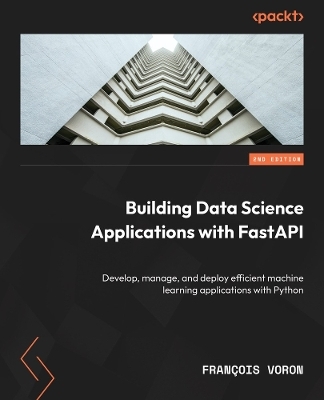
Building Data Science Applications with FastAPI
Packt Publishing Limited (Verlag)
978-1-83763-274-9 (ISBN)
Purchase of the print or Kindle book includes a free PDF eBook
Key Features
Uncover the secrets of FastAPI, including async I/O, type hinting, and dependency injection
Learn to add authentication, authorization, and interaction with databases in a FastAPI backend
Develop real-world projects using pre-trained AI models
Book DescriptionBuilding Data Science Applications with FastAPI is the go-to resource for creating efficient and dependable data science API backends. This second edition incorporates the latest Python and FastAPI advancements, along with two new AI projects – a real-time object detection system and a text-to-image generation platform using Stable Diffusion.
The book starts with the basics of FastAPI and modern Python programming. You'll grasp FastAPI's robust dependency injection system, which facilitates seamless database communication, authentication implementation, and ML model integration. As you progress, you'll learn testing and deployment best practices, guaranteeing high-quality, resilient applications.
Throughout the book, you'll build data science applications using FastAPI with the help of projects covering common AI use cases, such as object detection and text-to-image generation. These hands-on experiences will deepen your understanding of using FastAPI in real-world scenarios.
By the end of this book, you'll be well equipped to maintain, design, and monitor applications to meet the highest programming standards using FastAPI, empowering you to create fast and reliable data science API backends with ease while keeping up with the latest advancements.What you will learn
Explore the basics of modern Python and async I/O programming
Get to grips with basic and advanced concepts of the FastAPI framework
Deploy a performant and reliable web backend for a data science application
Integrate common Python data science libraries into a web backend
Integrate an object detection algorithm into a FastAPI backend
Build a distributed text-to-image AI system with Stable Diffusion
Add metrics and logging and learn how to monitor them
Who this book is forThis book is for data scientists and software developers interested in gaining knowledge of FastAPI and its ecosystem to build data science applications. Basic knowledge of data science and machine learning concepts and how to apply them in Python is recommended.
François Voron graduated from the University of Saint-Étienne (France) and the University of Alicante (Spain) with a master's degree in machine learning and data mining. A full stack web developer and a data scientist, François has a proven track record working in the SaaS industry, with a special focus on Python backends and REST APIs. He is also the creator and maintainer of FastAPI Users, the #1 authentication library for FastAPI, and is one of the top experts in the FastAPI community.
Table of Contents
Python Development Environment Setup
Python Programming Specificities
Developing a RESTful API with FastAPI
Managing Pydantic Data Models in FastAPI
Dependency Injection in FastAPI
Databases and Asynchronous ORMs
Managing Authentication and Security in FastAPI
Defining WebSockets for Two-Way Interactive Communication in FastAPI
Testing an API Asynchronously with pytest and HTTPX
Deploying a FastAPI Project
Introduction to Data Science in Python
Creating an Efficient Prediction API Endpoint with FastAPI
Implementing a Real-Time Object Detection System Using WebSockets with FastAPI
Creating a Distributed Text-to-Image AI System Using the Stable Diffusion Model
Monitoring the Health and Performance of a Data Science System
| Erscheinungsdatum | 20.07.2023 |
|---|---|
| Verlagsort | Birmingham |
| Sprache | englisch |
| Maße | 191 x 235 mm |
| Themenwelt | Mathematik / Informatik ► Informatik ► Datenbanken |
| Informatik ► Software Entwicklung ► SOA / Web Services | |
| Informatik ► Software Entwicklung ► User Interfaces (HCI) | |
| Mathematik / Informatik ► Informatik ► Web / Internet | |
| ISBN-10 | 1-83763-274-X / 183763274X |
| ISBN-13 | 978-1-83763-274-9 / 9781837632749 |
| Zustand | Neuware |
| Informationen gemäß Produktsicherheitsverordnung (GPSR) | |
| Haben Sie eine Frage zum Produkt? |
aus dem Bereich


